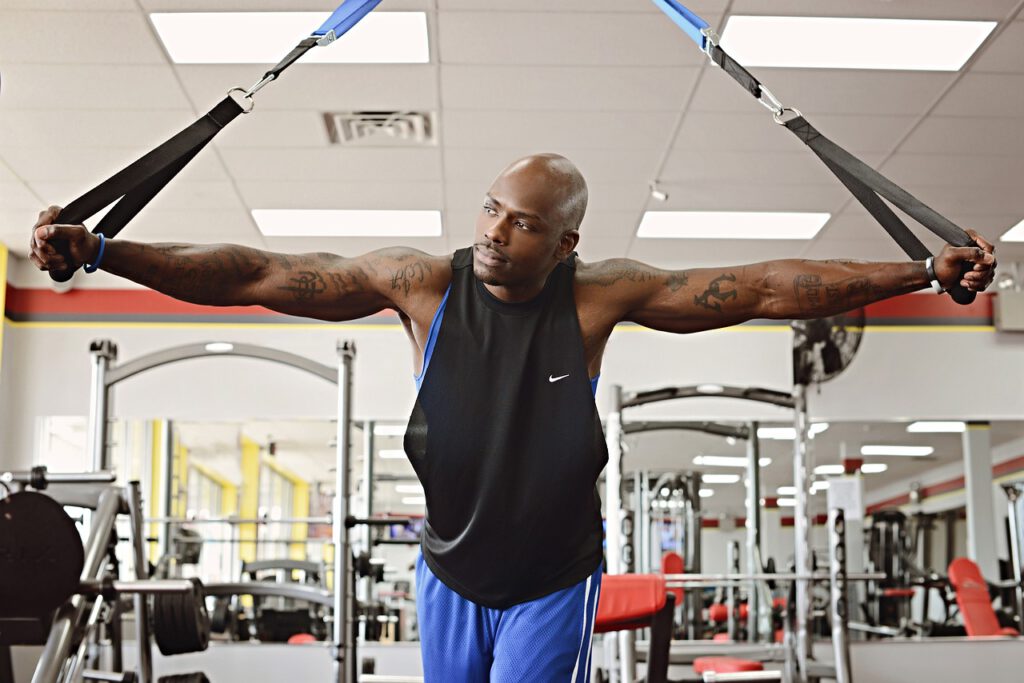
Gynecomastia, or enlargement of breast tissue in men, is a common condition that can cause distress and embarrassment. Although it is not life-threatening, it can take a toll on your self-esteem and quality of life. Fortunately, there are ways to reduce the appearance of gynecomastia and get rid of it for good. In this article, you will learn about the causes of gynecomastia, how to diagnose it correctly, and what treatment options are available to treat the condition.
Gynecomastia affects an estimated 40-60% of men at some point in their lives. It is caused by changes in hormone levels during puberty, drug side effects, tumors or other medical conditions, or simply due to aging. It can be embarrassing and uncomfortable for those affected by it, but fortunately there are several options available to reduce its appearance or even get rid of it altogether.
Many men feel embarrassed to talk about their gynecomastia with a doctor or seek treatment for the condition. However, if left untreated it can lead to serious physical and psychological issues that may require medical intervention down the line. With the right information about diagnosis and treatment options for gynecomastia, you can reclaim your confidence and get rid of this condition once and for all!
1. What Is Gynecomastia?
Gynecomastia is a medical condition that affects boys and men of all ages and is characterized by the enlargement of male breast tissue. It’s caused by an imbalance in hormones, resulting in too much estrogen and not enough testosterone. This can cause physical discomfort as well as emotional distress.
The first step to getting rid of gynecomastia is understanding what it is. While it can be embarrassing for some, having gynecomastia does not indicate any underlying health issues or diseases. In most cases, it can be managed with lifestyle changes such as exercise and diet.
It’s also important to understand the potential causes of gynecomastia so that you can make informed decisions about how to manage it. These may include hormone imbalances, certain medications, illicit drugs or alcohol use, or tumors on the testicles or adrenal glands. Each of these can contribute to the development of gynecomastia and should be evaluated by a doctor if they are suspected to be causing your symptoms. With this knowledge, you can take steps towards managing your condition in a way that works best for you.
2. Causes Of Gynecomastia
Chronic gynecomastia can be a nightmare for many men, but it’s important to understand what causes this condition before seeking treatment. To that end, let’s look at the causes of gynecomastia and how to combat them.
First, let’s consider the external factors that can lead to gynecomastia. These include:
- Hormonal imbalances: This is one of the most common causes of gynecomastia, and usually occurs when testosterone levels decrease while estrogen levels increase.
- Medications: Certain medications like antidepressants and ulcer drugs can trigger hormone imbalances that lead to the growth of breast tissue in some men. • Excessive alcohol consumption and marijuana use: Overindulging in these substances can also contribute to hormonal imbalances that cause gynecomastia.
In addition to these external factors, there are several internal issues that can cause or exacerbate gynecomastia. These include:
• Liver disease: A damaged liver has difficulty processing hormones, which leads to an imbalance in testosterone and estrogen levels.
• Kidney disease: Similarly, kidney issues can also disrupt hormone levels.
• Obesity: Being overweight is associated with higher estrogen levels, which contributes to the growth of male breast tissue.
But simply understanding the various causes isn’t enough; it’s important to know how they can be treated as well. In the next section we’ll explore the treatments available for those suffering from gynecomastia so they don’t have to live with this condition any longer.
3. Treatments Available
Gynecomastia affects up to 60% of men at some point during their lifetime. For those looking for treatments, there are a few options available. Here are three treatments that can help reduce the effects of gynecomastia:
First, lifestyle changes such as diet and exercise can be beneficial in reducing the appearance of gynecomastia. Eating a balanced diet full of fruits and vegetables, plus regular exercise can help build muscle mass and reduce fat around the chest area. This won’t completely get rid of gynecomastia, but it could reduce its appearance.
Second, medications such as Raloxifene or Tamoxifen have been used to treat gynecomastia in some cases. These drugs work by blocking the effects of estrogen on breast tissue, which can help reduce the amount of breast tissue present. However, these medications should only be used under the guidance of a physician because they can have serious side effects such as an increased risk for blood clots and stroke.
Third, there are also topical creams that have been used to treat gynecomastia with some success. These creams contain ingredients such as retinoids or alpha hydroxy acids which may help reduce the appearance of enlarged breasts due to gynecomastia. While these treatments may not completely get rid of gynecomastia, they could be helpful in reducing its appearance.
Although lifestyle changes and medications provide some relief from gynecomastia symptoms, surgery is usually required for more severe cases. It’s important to discuss all risks associated with surgery with your doctor before proceeding with any kind of treatment plan so you’re fully informed about what you’re getting into. Moving forward into discussing surgery and its risks is important when considering treatment for gynecomastia.
4. Surgery And Its Risks
Sometimes, when all else fails, surgery may be the only way to get rid of gynecomastia. It’s a last resort, however, and comes with a few risks that should be considered.
Surgery for gynecomastia can come in two forms: liposuction or excision. Liposuction is the most common form and involves sucking out fatty tissue from the chest with a vacuum-like device. Excision involves removing glandular tissue through an incision in the chest. Both options can be done under local or general anesthesia depending on your situation, and require some downtime post-surgery.
As with any surgery, there are associated risks like infection, scarring, and changes in nipple sensation. Of course, your doctor will discuss all the potential risks before you make a decision about what type of surgery is right for you. But if you’re tired of living with gynecomastia and have tried other treatments without success, it might be worth considering surgery as an option. From here we’ll look at nonsurgical treatments that might help reduce the appearance of this condition.
5. Nonsurgical Treatments
John, a 40-year-old accountant, suffered from gynecomastia for more than five years. He wanted to get rid of it, but was afraid of the risks and costs of surgery. Fortunately, there are several non-surgical treatments available for this condition:
- Hormone therapy – this helps to reduce the production of estrogen in men’s bodies.
- Medications – some medications can be used to reduce the amount of breast tissue or fat in the chest area.
- Cool Sculpting – this non-invasive procedure uses cold temperatures to freeze and kill fat cells in the chest area.
- Injections – certain injections can be used to reduce the size of enlarged breasts.
- Laser treatments – laser treatments can also be used to reduce the appearance of gynecomastia by breaking down fat cells.
These non-surgical treatments offer a safe and effective way to reduce the size of enlarged breasts without any major risks or side effects. They are generally less expensive than surgery and have fewer recovery times. However, it is important to consult with your doctor before starting any treatment to determine the best option for you.
The next step is exploring natural remedies for gynecomastia, such as dietary changes and home remedies that may help treat this condition naturally.
6. Natural Remedies
There is more you can do to get rid of gynecomastia – even if you don’t want to go the surgical route. Natural remedies are an alternative that may help with reducing the symptoms of this condition. Let’s take a look at what these remedies involve.
First, there are natural herbs and supplements that can be taken to help reduce the swelling caused by gynecomastia:
• Milk thistle is one such herb which has anti-inflammatory properties.
• Fenugreek extract has long been used in traditional medicine for treating swelling.
• Vitamin E is also believed to have anti-inflammatory properties, making it beneficial in reducing gynecomastia symptoms.
• Saw palmetto extract is also thought to be beneficial in reducing swelling associated with this condition.
Next, there are lifestyle changes that you can make to help reduce the risk of developing or worsening gynecomastia:
• Avoiding alcohol consumption and limiting your intake of processed foods could be beneficial for reducing gynecomastia symptoms.
• Eating more fruits and vegetables, as well as lean proteins, can be beneficial for maintaining healthy hormone levels in the body which could reduce the risk of developing gynecomastia.
• Maintaining an active lifestyle can also be helpful in promoting healthy hormones and keeping your weight within a healthy range which could reduce your risk of developing or worsening this condition.
• Exercising regularly and following a balanced diet can help keep your hormones balanced, which may reduce your risk of developing or worsening gynecomastia. Taking these steps could help you naturally manage your symptoms without having to resort to surgery. With some lifestyle and diet changes, you may find yourself on the path towards better health and reduced symptoms from this condition.
7. Lifestyle And Diet Changes
As if the physical discomfort wasn’t enough, dealing with gynecomastia can be a huge emotional burden. It’s hard to feel confident when you’re constantly worrying about your chest. But there is hope – lifestyle and diet changes can help reduce the size of enlarged breasts.
This isn’t a quick fix, but making tweaks to your everyday habits can pay off in the long run. First, cut down on processed and sugary foods, especially those that contain hormones or xenoestrogens like soy products or dairy. Eating a clean, balanced diet can help balance out hormone levels and boost testosterone production naturally.
Also, be sure to stay hydrated throughout the day and avoid alcohol as much as possible since it interferes with testosterone production. All of these changes will not only improve your overall health but also benefit you in terms of gynecomastia reduction. With proper nutrition and regular hydration, you’ll be able to see positive changes in your chest size over time.
Taking control of your diet and lifestyle is one of the best steps you can take toward reducing gynecomastia symptoms. Armed with this knowledge, you’re ready to tackle exercise and strength training to further reduce breast tissue growth.
8. Exercise And Strength Training
It is often said that exercise and strength training can help to reduce the symptoms of gynecomastia in men. But is this really true? Can a few sets of push-ups actually aid in reducing enlarged breast tissue? A closer look into the scientific evidence may provide some answers.
Research shows that exercise and strength training can, indeed, reduce the size of swollen breast tissue. To get rid of gynecomastia, a man should focus on doing chest exercises like bench presses, push-ups, and chest flys. These exercises target the pectoral muscles and can help to strengthen them, which will ultimately reduce the appearance of enlarged breasts. Additionally, exercising regularly increases testosterone levels which also helps to reduce gynecomastia symptoms.
Therefore, it is clear that exercise and strength training are effective tools for reducing gynecomastia symptoms in men. However, it’s important to remember that these methods may take weeks or months before any noticeable changes are seen – they require patience and dedication. Moving on from here, understanding when it’s time to see a doctor could be beneficial for those experiencing persistent gynecomastia symptoms.
9. When To See A Doctor
Gynecomastia has been a problem for many men, and while many solutions have been proposed, they don’t always work. You’d think the last resort would be to see a doctor – but it’s actually the first thing you should do! Strangely enough, seeking medical advice is not just the most sensible option – it’s actually the only one that guarantees results.
You may wonder why seeing a doctor is necessary in cases of gynecomastia. The answer lies in the fact that there are several causes behind this condition, some of which require more complex treatment than what can be achieved with simple lifestyle changes or exercise. It’s important to get an accurate diagnosis from a qualified health professional before beginning any kind of treatment.
In addition to providing an accurate diagnosis, doctors can also provide valuable guidance regarding the best course of action for treating your particular case of gynecomastia. Depending on its severity and cause, you may need medications or even surgery in order to achieve satisfactory results. So don’t wait until things get out of hand: if you’re experiencing signs or symptoms of gynecomastia, make sure you book an appointment with your doctor as soon as possible!
The bottom line is clear: if you want to tackle your gynecomastia woes effectively and safely, consulting with a medical professional is absolutely essential. Not only will they be able to provide a better understanding of the underlying cause of your condition and how best to treat it – they might just be able to save you from further frustration down the line!
10. Key Takeaways
Gynecomastia can be a difficult condition to deal with, but thankfully there are treatments available that can help. In this article, we’ve explored the nine key steps on how to get rid of gynecomastia – and now it’s time for the final step: the key takeaways! Absolutely astounding!
The main takeaway here is that gynecomastia is a very common condition, so don’t be afraid to ask your doctor about it. It is possible to reduce its symptoms with diet and lifestyle changes such as exercise, reducing alcohol consumption, quitting smoking, and taking medications such as diuretics or tamoxifen. However, if you feel like you need more help or your symptoms worsen over time, it may be best to seek professional medical advice.
Remember that gynecomastia can affect men of any age and size. Don’t let it hold you back from living your life – take care of yourself and reach out for help when needed. With the right treatment plan in place, you can reduce and even eliminate the symptoms of gynecomastia for good.
Frequently Asked Questions
How Long Does It Take To Get Rid Of Gynecomastia?
Getting rid of gynecomastia is no small feat – it can seem like a never-ending journey. But with the right guidance and plan, there’s sure to be light at the end of the tunnel! So if you’re wondering how long it takes to get rid of gynecomastia, you’ve come to the right place.
Well, the truth is that there’s no one-size-fits-all answer for this question. Everyone’s body is different and so everyone’s experience with gynecomastia will differ as well. Depending on the severity of your condition, it could take anywhere from a few weeks to several months before you start seeing results. That said, there are certain things you can do to speed up the process, such as adopting an appropriate exercise routine and following a healthy diet. These lifestyle changes can help reduce fat deposits in your chest area, which in turn can help reduce the appearance of gynecomastia over time.
It goes without saying that patience is key here – but don’t let that discourage you! With dedication comes great rewards – you’ll be amazed by how far you can go if you stay consistent with your efforts and remain focused on your goal. After all, it may not happen overnight – but trust us when we say that it’ll be worth it in the end!
Is Gynecomastia Permanent?
Gynecomastia can be a frustrating and embarrassing condition – a physical manifestation of something deeper that many men struggle to grapple with. It’s an unwelcome reminder of the ever-present pressure to live up to the masculine ideal. But is it permanent?
The answer, unfortunately, isn’t so one-dimensional. It depends on several factors such as age, hormone levels and underlying medical conditions. For some men, gynecomastia may resolve itself over time with no treatment at all. However, for other men, the condition may persist indefinitely if not treated appropriately.
The best way to find out whether gynecomastia is permanent or not is to consult a doctor who can assess your individual situation and suggest the most suitable course of action. This could include lifestyle changes, medication or even surgery. Ultimately, though it can feel overwhelming and daunting at first, finding a solution to this issue is possible.
Is There Any Way To Prevent Gynecomastia From Happening?
Gynecomastia is a condition that affects many men and can be embarrassing and uncomfortable. It involves the enlargement of glandular tissue in the chest area, leading to a feminine-looking chest. Fortunately, there are ways to prevent gynecomastia from happening in the first place.
For those who have not yet developed gynecomastia, there are steps you can take to reduce your chances of getting it. Firstly, maintain a healthy lifestyle with regular exercise and a balanced diet. Secondly, avoiding certain drugs such as steroids or marijuana is recommended; these substances can increase the risk of developing gynecomastia. Finally, reducing your exposure to environmental toxins like BPA or phthalates may also help you steer clear of this condition.
It’s important to understand that prevention has its limits; even if you do everything right there’s still no guarantee that you won’t develop any symptoms. However, by following the right steps you can drastically reduce your chances of getting gynecomastia in the first place. Being aware of potential issues and taking proactive measures can go a long way in keeping your body healthy and looking great!
Are There Any Medications That Can Help Reduce Gynecomastia?
When it comes to gynecomastia, prevention is key. But if you’ve already developed the condition, there are medications that may help reduce its effects. It’s important to note, however, that these treatments may not be effective for everyone.
In some cases, medications like tamoxifen and raloxifene can help reduce the size of breast tissue in men with gynecomastia. These medications work by blocking estrogen in the body, which can reduce the growth of breast tissue. Other drugs like clomiphene and anastrozole can also be used to treat the condition in some men.
It’s always best to consult a doctor before taking any medication for gynecomastia. Your doctor will be able to assess your individual situation and determine which treatment option is right for you. They may also recommend lifestyle changes or other treatments that could help improve your symptoms and reduce your risk of recurrence.
How Successful Are The Surgical And Nonsurgical Treatments For Gynecomastia?
Tackling gynecomastia can be a daunting task, but it doesn’t have to be. With both surgical and nonsurgical treatments available, you can find the best solution for your needs. So, how successful are these treatments? Let’s take an in-depth look!
Like all things, there are pros and cons to each treatment option. For example, while they can provide long-term results in some cases, surgical treatments can be costly and require a long recovery period. On the other hand, nonsurgical treatments tend to be cheaper and less invasive but may not offer long-term results in every case.
It’s important to remember that everyone is different and what works for one person may not work for another. That’s why it’s so important to weigh your options carefully before making a decision. As the old saying goes: ‘when you know better, you do better’. So why not take advantage of that knowledge and choose the treatment that works best for you?
Conclusion
In conclusion, gynecomastia can be an uncomfortable and embarrassing condition that affects many men. The good news is that there are treatments available to help reduce the size of enlarged male breasts. Depending on the cause of the gynecomastia, some treatments may be more successful than others. While there is no sure-fire way to prevent gynecomastia, making lifestyle changes such as reducing alcohol intake and following a balanced diet can help reduce the risk.
Ultimately, it is up to you and your doctor to decide which treatment plan will work best for you. It is important to remember that while some treatments may take several months or even years to produce results, they can still be effective in reducing and eliminating gynecomastia. As the old saying goes, ‘patience is a virtue.’ With the right care and dedication, you can get back to enjoying life without the worry of having enlarged breasts.
Check out some of the best Gynecomastia supplements



